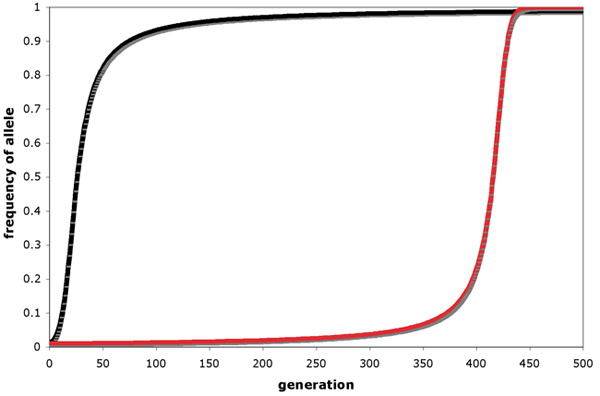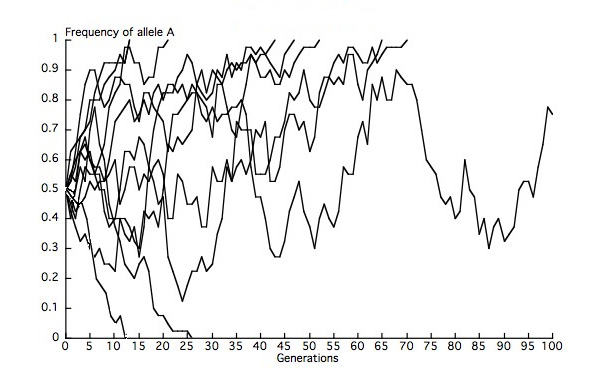Which Of The Following Events Do Biologists Consider A Random Change
Natural choice, genetic drift, and gene flow are the mechanisms that crusade changes in allele frequencies over time. When one or more of these forces are interim in a population, the population violates the Hardy-Weinberg assumptions, and evolution occurs. The Hardy-Weinberg Theorem thus provides a null model for the written report of evolution, and the focus of population genetics is to understand the consequences of violating these assumptions.
Natural selection occurs when individuals with certain genotypes are more likely than individuals with other genotypes to survive and reproduce, and thus to pass on their alleles to the next generation. As Charles Darwin (1859) argued in On the Origin of Species, if the following conditions are met, natural selection must occur:
- There is variation among individuals within a population in some trait.
- This variation is heritable (i.e., at that place is a genetic basis to the variation, such that offspring tend to resemble their parents in this trait).
- Variation in this trait is associated with variation in fitness (the average internet reproduction of individuals with a given genotype relative to that of individuals with other genotypes).
Directional selection leads to increase over fourth dimension in the frequency of a favored allele. Consider three genotypes (AA, Aa and aa) that vary in fitness such that AA individuals produce, on average, more offspring than individuals of the other genotypes. In this case, assuming that the selective authorities remains constant and that the action of selection is the only violation of Hardy-Weinberg assumptions, the A allele would become more common each generation and would eventually become fixed in the population. The rate at which an advantageous allele approaches fixation depends in part on the dominance relationships among alleles at the locus in question (Effigy 1). The initial increase in frequency of a rare, advantageous, dominant allele is more rapid than that of a rare, advantageous, recessive allele because rare alleles are plant mostly in heterozygotes. A new recessive mutation therefore tin't exist "seen" by natural option until it reaches a loftier enough frequency (perchance via the random effects of genetic drift — see beneath) to beginning appearing in homozygotes. A new dominant mutation, however, is immediately visible to natural choice because its effect on fitness is seen in heterozygotes. One time an advantageous allele has reached a high frequency, deleterious alleles are necessarily rare and thus mostly present in heterozygotes, such that the final approach to fixation is more rapid for an advantageous recessive than for an advantageous dominant allele. As a upshot, natural pick is not as effective every bit one might naively expect it to be at eliminating deleterious recessive alleles from populations.

Effigy 1: Allele-frequency modify under directional selection favoring (a) a dominant advantageous allele and (b) a recessive advantageous allele
Balancing pick, in contrast to directional selection, maintains genetic polymorphism in populations. For instance, if heterozygotes at a locus have higher fitness than homozygotes (a scenario known as heterozygote advantage or overdominance), natural choice will maintain multiple alleles at stable equilibrium frequencies. A stable polymorphism can besides persist in a population if the fitness associated with a genotype decreases as that genotype increases in frequency (i.e., if there is negative frequency-dependent selection). Information technology is of import to note that heterozygote disadvantage (underdominance) and positive frequency-dependent pick can too act at a locus, but neither maintains multiple alleles in a population, and thus neither is a form of balancing selection.
Genetic migrate results from the sampling error inherent in the transmission of gametes past individuals in a finite population. The gamete pool of a population in generation t is the full pool of eggs and sperm produced past the individuals in that generation. If the gamete pool were infinite in size, and if at that place were no pick or mutation acting at a locus with two alleles (A and a), we would look the proportion of gametes containing the A allele to exactly equal the frequency of A, and the proportion of gametes containing a to equal the frequency of a. Compare this situation to tossing a fair coin. If y'all were to toss a coin an space number of times, the proportion of heads would exist 0.l, and the proportion of tails would exist 0.50. If you lot toss a money merely 10 times, however, you shouldn't be too surprised to get 7 heads and 3 tails. This deviation from the expected head and tail frequencies is due to sampling error. The more times you toss the money, the closer these frequencies should come to 0.l because sampling error decreases as sample size increases.
In a finite population, the adults in generation t will pass on a finite number of gametes to produce the offspring in generation t + 1. The allele frequencies in this gamete puddle will generally deviate from the population frequencies in generation t because of sampling error (again, assuming there is no selection at the locus). Allele frequencies will thus change over time in this population due to chance events — that is, the population will undergo genetic drift. The smaller the population size (N), the more important the effect of genetic drift. In practice, when modeling the effects of migrate, we must consider effective population size (Northwarde ), which is essentially the number of breeding individuals, and may differ from the demography size, N, under various scenarios, including diff sex ratio, certain mating structures, and temporal fluctuations in population size.
At a locus with multiple neutral alleles (alleles that are identical in their furnishings on fitness), genetic drift leads to fixation of one of the alleles in a population and thus to the loss of other alleles, such that heterozygosity in the population decays to zero. At any given time, the probability that one of these neutral alleles volition eventually exist fixed equals that allele'south frequency in the population. Nosotros can think almost this result in terms of multiple replicate populations, each of which represents a deme (subpopulation) within a metapopulation (collection of demes). Given 10 finite demes of equal Ne , each with a starting frequency of the A allele of 0.5, nosotros would expect eventual fixation of A in five demes, and eventual loss of A in 5 demes. Our observations are likely to deviate from those expectations to some extent considering we are considering a finite number of demes (Figure two). Genetic migrate thus removes genetic variation within demes but leads to differentiation amidst demes, completely through random changes in allele frequencies.

Figure 2: Simulations of allele-frequency change in 10 replicate populations (Due north = 20)
Since the initial frequency of the A allele = 0.5, nosotros wait A to be fixed in 5 populations and lost in 5 populations, just our observations deviate from expectations considering of the finite number of populations. In this run of simulations, we see 7 instances of fixation (p = 1), 2 instances of loss (p = 0), and one instance in which at that place are however ii alleles subsequently 100 generations. In this last population, A would eventually reach fixation or loss.
Cistron flow is the motion of genes into or out of a population. Such movement may be due to migration of private organisms that reproduce in their new populations, or to the movement of gametes (due east.g., as a outcome of pollen transfer among plants). In the absence of natural pick and genetic migrate, gene flow leads to genetic homogeneity among demes within a metapopulation, such that, for a given locus, allele frequencies volition achieve equilibrium values equal to the average frequencies across the metapopulation. In contrast, restricted cistron flow promotes population divergence via option and drift, which, if persistent, can atomic number 82 to speciation.
Natural selection, genetic drift and gene flow do non act in isolation, and so nosotros must consider how the coaction amid these mechanisms influences evolutionary trajectories in natural populations. This outcome is crucially important to conservation geneticists, who grapple with the implications of these evolutionary processes as they blueprint reserves and model the population dynamics of threatened species in fragmented habitats. All real populations are finite, and thus bailiwick to the furnishings of genetic migrate. In an infinite population, we expect directional pick to eventually set up an advantageous allele, just this will not necessarily happen in a finite population, because the effects of drift can overcome the effects of selection if selection is weak and/or the population is small. Loss of genetic variation due to drift is of particular concern in small, threatened populations, in which fixation of deleterious alleles tin can reduce population viability and enhance the risk of extinction. Even if conservation efforts boost population growth, low heterozygosity is likely to persist, since bottlenecks (periods of reduced population size) take a more pronounced influence on Ne than periods of larger population size.
We have already seen that genetic drift leads to differentiation among demes within a metapopulation. If nosotros assume a simple model in which individuals have equal probabilities of dispersing among all demes (each of effective size Northe ) within a metapopulation, and then the migration rate (m) is the fraction of gene copies within a deme introduced via clearing per generation. According to a commonly used approximation, the introduction of only one migrant per generation (Ne m = 1) constitutes sufficient gene flow to annul the diversifying effects of genetic drift in a metapopulation.
Natural selection tin can produce genetic variation among demes within a metapopulation if different selective pressures prevail in different demes. If Ndue east is big enough to discount the effects of genetic migrate, then nosotros expect directional pick to ready the favored allele within a given focal deme. Notwithstanding, the continual introduction, via factor flow, of alleles that are advantageous in other demes but deleterious in the focal deme, can annul the effects of pick. In this scenario, the deleterious allele will remain at an intermediate equilibrium frequency that reflects the balance between gene catamenia and natural option.
Source: https://www.nature.com/scitable/knowledge/library/natural-selection-genetic-drift-and-gene-flow-15186648/
Posted by: mintonglage1957.blogspot.com


0 Response to "Which Of The Following Events Do Biologists Consider A Random Change"
Post a Comment